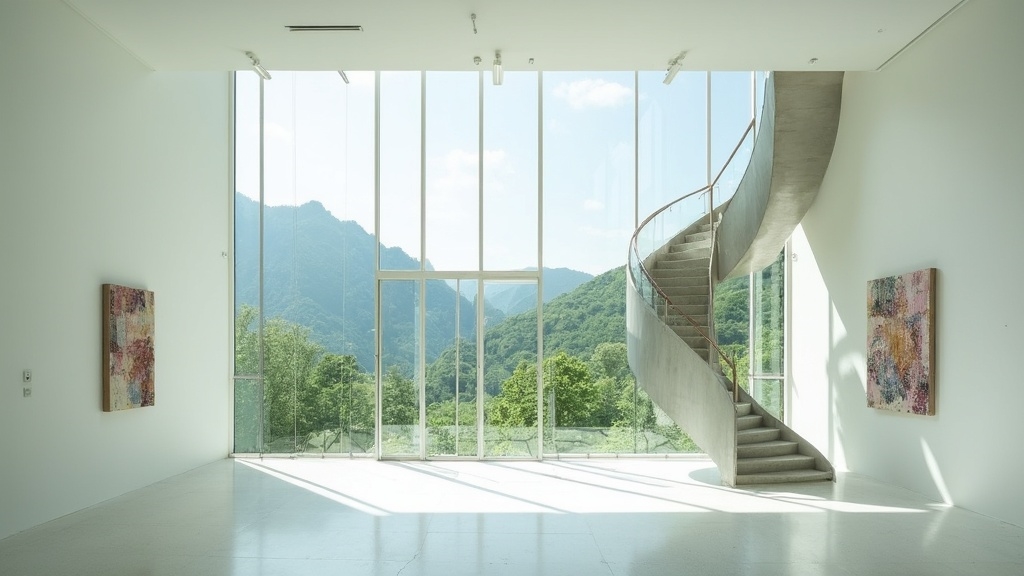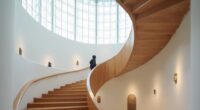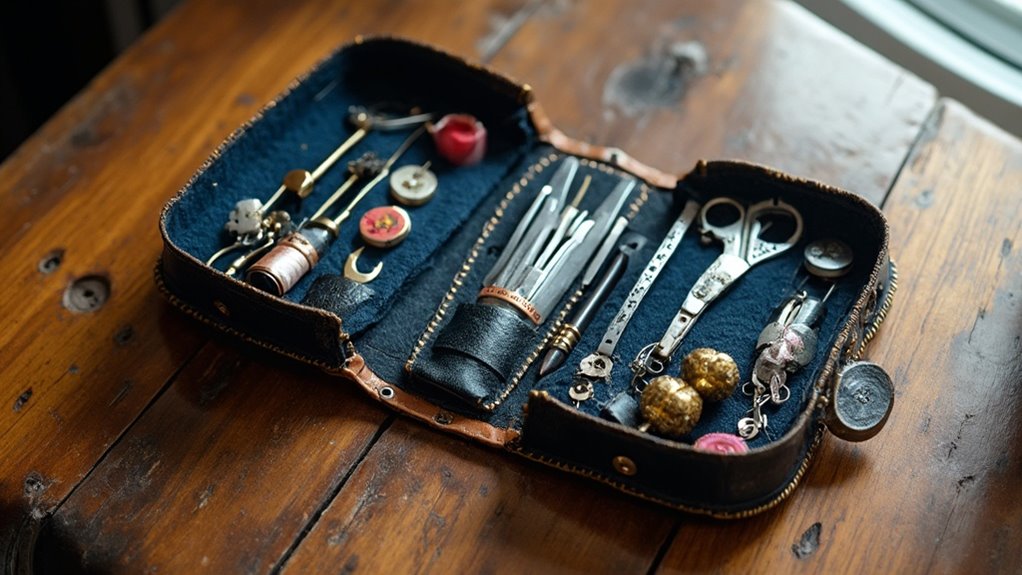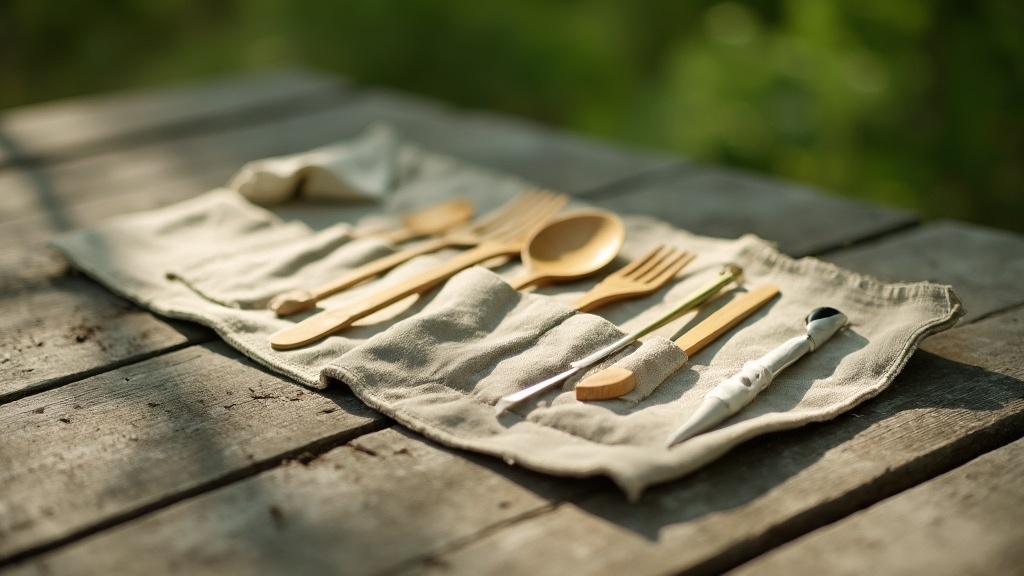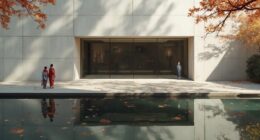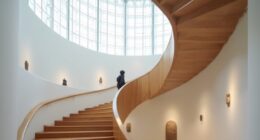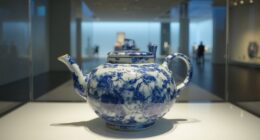Table of Contents Show
There may be products. Products are independently selected by our editors. We may earn an affiliate commission from the links with no charge to you, example: as Amazon Affiliate.
Kanagawa Prefecture features diverse art museums spanning modern, contemporary, and traditional Japanese art. The Yokohama Museum of Art in Minato Mirai showcases prominent international artists, while Kawasaki’s art spaces highlight emerging talent. Historical collections trace cultural evolution at the Prefectural Museum of Cultural History. Traditional galleries like the Hakone Museum of Art combine exhibitions with scenic gardens. This rich artistic landscape offers countless opportunities to explore Japan’s cultural heritage.
Key Takeaways
- Yokohama Museum of Art, designed by Kenzo Tange, features modern art collections including works by Cézanne, Picasso, and Dalí.
- Art Garden Kawasaki serves as a contemporary art hub, showcasing works by rising artists like Yukimasa Ida and Shozo Taniguchi.
- The Pola Museum in Hakone houses an extensive private collection of Western and Japanese artworks in a modern setting.
- Kanagawa Prefectural Museum of Cultural History displays historical art collections across five periods in a culturally significant building.
- The Hakone Open-Air Museum combines outdoor sculpture exhibitions with traditional Japanese art in a natural landscape setting.
Modern Art Museums in Yokohama’s Minato Mirai District
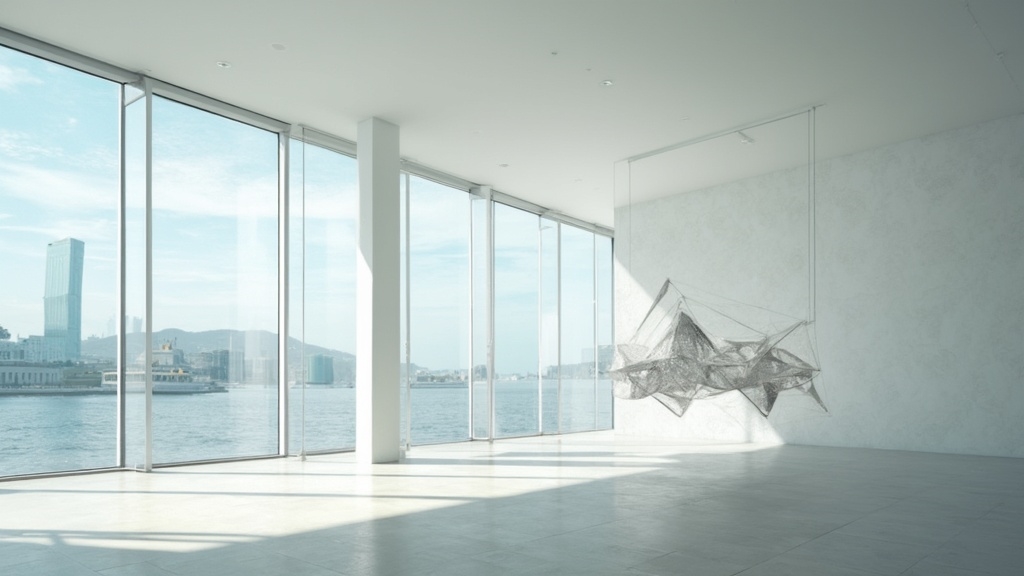
While Yokohama’s Minato Mirai district is known for its modern skyline and commercial attractions, its art museum stands as a cultural cornerstone of the area. Designed by Kenzo Tange and established in 1989, the museum reopened in February 2025 following extensive renovations. The institution houses seven galleries and an extensive library containing over 110,000 art books. The museum’s main hall features an impressive 18 meters tall ceiling with abundant natural lighting through glass panels.
The museum’s collection emphasizes modern and contemporary art from the late 19th century to present day, featuring works by masters such as Cézanne, Picasso, and Dalí. This engagement with cultural diversity allows visitors to appreciate the varied interpretations of art across different cultures. Located near Yokohama Landmark Tower and Grand Mall Park, the museum enriches the community through interactive exhibits and cultural events. Its rotating temporary exhibitions complement the permanent collection, making it a crucial destination for art enthusiasts and cultural engagement in Kanagawa Prefecture. The museum makes art accessible to young visitors by offering free admission to high school students on Saturdays with valid identification. The exhibition provides unique insights into pre-1859 Yokohama, showcasing life before the city opened to foreign trade.
Historical Art Collections in Kanagawa Prefecture
Beyond the contemporary art scene, Kanagawa Prefecture harbors significant historical art collections that trace the region’s cultural evolution from ancient times through the Edo period. The region’s museums preserve and showcase artifacts that illuminate the artistic heritage of the Sagami area and its surrounding territories. Many collections feature nihonga paintings, as exemplified by the Narukawa Art Museum’s extensive display of traditional Japanese-style artworks. Cultural encounters encourage reflection on personal values and biases, enhancing the overall experience of exploring the region’s artistic history.
- The Kanagawa Prefectural Museum of Cultural History presents historical exhibitions chronicling five distinct periods, from ancient settlements to the modernization of Japan.
- Historical collections feature regional artists who captured the essence of traditional Japanese society, particularly during the cultural transformations of the Edo and Meiji periods.
- The museum’s permanent collection, housed in a 1904 building designated as an Important Cultural Property, offers visitors thorough insights into local artistic developments through carefully curated displays and multilingual interpretive materials.
The museum’s extensive book collection is available for public research and reference. Visitors can explore these exhibitions with ease through audio guides available in Japanese, English, Chinese, and Korean languages.
Contemporary Art Spaces in Kawasaki
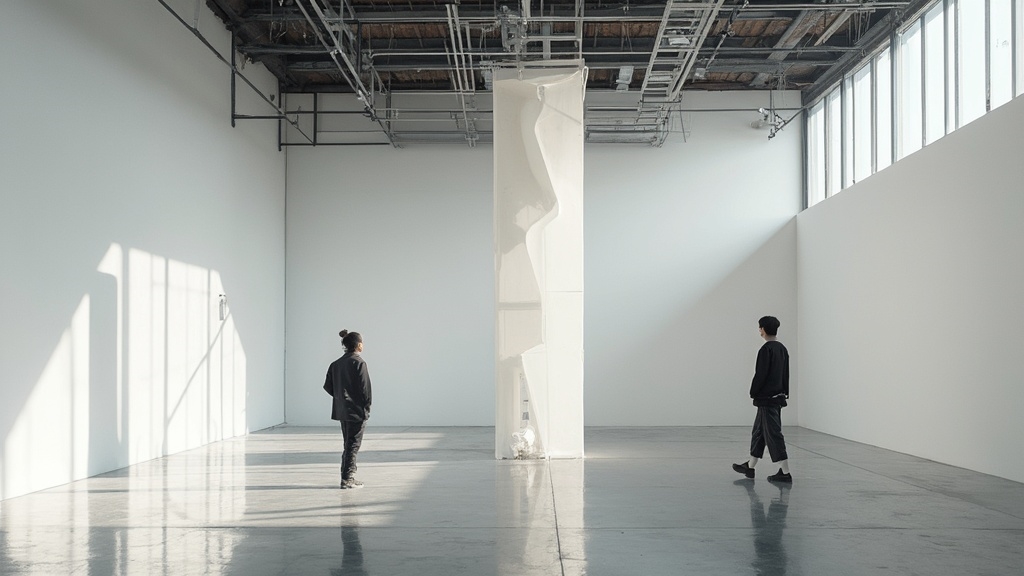
In contrast to its historical institutions, Kawasaki’s contemporary art scene thrives through private collectors who embrace works from artists of diverse nationalities. Notable Kawasaki collectors have integrated significant contemporary exhibitions into their homes, featuring expansive canvases that showcase emerging talent. The Art Garden Kawasaki provides an important community hub where these private collections occasionally merge with public exhibitions, fostering cultural exchange that enriches the local artistic landscape.
The collections prominently display works by rising artists such as Yukimasa Ida, KYNE, and Shozo Taniguchi, alongside pieces by Yu Kawashima, Miwa Komatsu, and Ayako Rokkaku. These collectors demonstrate a commitment to supporting artists regardless of their national origins, creating intimate viewing spaces that challenge traditional museum settings. Their focus on large-scale contemporary works has transformed private residences into dynamic exhibition spaces, contributing to Kawasaki’s evolving identity as a hub for modern artistic expression. The Nakahara-ku district is particularly known for its vibrant street art installations that complement these private collections. Collectors often display artwork in unconventional spaces, with some pieces finding homes in private bathrooms, enhancing the daily art experience.
Traditional Japanese Art Galleries
Traditional Japanese art galleries in Kanagawa preserve centuries of cultural heritage through thoughtfully curated spaces and rotating exhibitions. The prefecture’s dedication to historical art preservation manifests through venues that showcase traditional craft exhibitions and classical masterpieces. These cultural institutions serve as essential links between past and present, allowing visitors to experience Japan’s rich artistic legacy. A prime example is the Enoura Observatory, where panoramic views allow visitors to appreciate art against stunning ocean vistas. The Enoura Observatory also emerges as a place where gaining new perspectives enhances the understanding of art through its creative settings. The Hakone Museum of Art enriches the cultural landscape with its celebrated moss garden that perfectly complements the traditional artwork displays. The Pola Museum of Art offers a unique experience where untouched nature harmoniously coexists with artistic masterpieces.
- The Enoura Observatory, established in 1936, displays folk crafts through quarterly rotating exhibitions that highlight regional artistic traditions.
- Traditional craft exhibitions throughout Kanagawa’s galleries feature ceramics, textiles, and calligraphy works that demonstrate time-honored techniques.
- The Byodoin Museum houses ancient artifacts and religious art pieces, maintaining strict preservation standards while making these treasures accessible to the public.
Specialized Art Museums and Collections
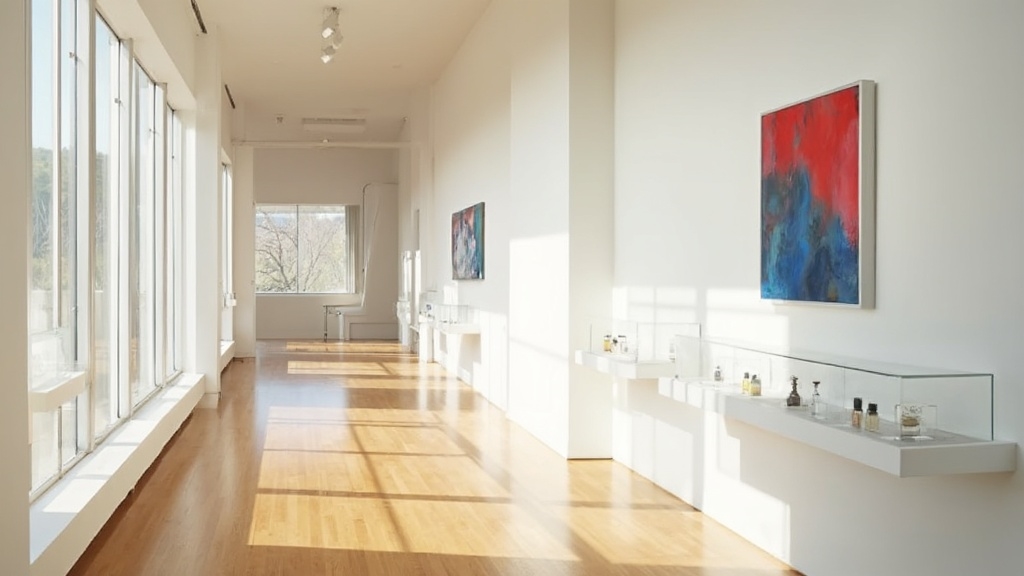
Kanagawa Prefecture houses several distinctive art museums and collections that showcase specialized themes, contemporary works, and unique artistic visions. Notable among these is The Museum of The Little Prince, the world’s first institution dedicated to Saint-Exupéry’s beloved tale, featuring immersive exhibits that bring the story to life. The KABOCYABIJUTSUKAN offers visitors interactive installations centered around Yayoi Kusama‘s iconic pumpkin artworks, combining visual art with dining experiences. The Yokosuka Museum of Art presents rotating niche exhibitions focusing on modern and contemporary Japanese artists. The Lalique Museum in Hakone stands out with its impressive collection of 230 Lalique pieces representing both Art Nouveau jewelry and Art Deco glass. In the historic Kannai district, a Meiji-era building from 1904 houses cultural exhibitions that complement the region’s artistic heritage. Additionally, many of these venues incorporate mindfulness practices that enhance the visitor experience through engaging interactions with the art. The Hakone Open-Air Museum displays outdoor sculptures across its expansive mountainous grounds, offering visitors art amid stunning seasonal landscapes. These specialized venues create meaningful connections between art and visitors through carefully curated displays, themed collections, and experiential presentations, offering deeper insights into specific artistic movements, individual creators, and cultural narratives.
Architectural Highlights of Kanagawa’s Museums
Architectural innovation defines the museum landscape of Kanagawa Prefecture, with several institutions showcasing significant developments in Japanese modern design. The cultural integration of modern architecture with traditional spaces is exemplified throughout these venues, demonstrating thoughtful architectural evolution across different eras. These spaces reflect similar principles to the Philip Johnson design that transformed museum gardens globally.
- The Museum of Modern Art, Kamakura Main Hall, designed by Junzo Sakakura in 1951, harmoniously blends modernist principles with its location within Tsurugaoka Hachiman-gū precincts. The design approach mirrors the pioneering work of Tange Kenzo, who created Japan’s first museum design incorporating symmetrical exhibition spaces. The innovative use of nested box layouts in exhibition areas maximizes space efficiency while protecting sensitive artworks from environmental factors.
- The Kamakura Annex, completed in 1984 by Masato Otaka, extends the museum’s capabilities through efficient spatial design and preservation-focused facilities.
- The Hayama Hall represents adaptive reuse of a royal villa, incorporating coastal views and experimental layouts while maintaining its historical character through carefully considered architectural elements.
Cultural Heritage Sites With Art Collections

Beyond the modern structures housing art collections, many of Kanagawa’s cultural heritage sites maintain significant artistic treasures within their historic walls. Temples like Hokokuji showcase Buddhist Art through carefully preserved statues and religious paintings, while traditional gardens serve as living canvases. Samurai Art finds its home in Odawara Castle, where historical artifacts and military craftwork document the region’s warrior legacy. The prefecture’s dedication to Open Air Collections manifests prominently at the Hakone Open-Air Museum, seamlessly integrating Traditional Sculpture with natural landscapes. Throughout these heritage sites, Cultural Artifacts tell stories of different eras, from religious ceremonies to daily life, creating a thorough artistic timeline of Kanagawa’s rich cultural past. Visitors can explore the NYK Maritime Museum to discover how Japan’s maritime routes influenced the artistic and cultural exchange between Japan and foreign nations since the Meiji era. The port city of Yokohama features numerous galleries showcasing international influences that have shaped the region’s artistic development since its opening as a major harbor.
Thematic Art Exhibitions and Venues
Throughout the prefecture’s diverse exhibition spaces, thematic art presentations captivate audiences through carefully curated displays and innovative venue designs. The Yokohama Museum of Art leads regional thematic trends with its reopening inaugural exhibition, while temporary installations showcase both traditional and contemporary Japanese artistic expressions. Various venues foster creative dialogue between artists and audiences through cross-disciplinary programming and community engagement initiatives.
- Major exhibition spaces feature rotating displays that reflect seasonal and cultural themes, incorporating multimedia art installations and interactive elements
- The Kanagawa Prefectural Art Exhibition promotes artistic excellence through specialized categories including 2D/3D works, crafts, calligraphy, and photography
- Digital platforms extend exhibition reach, exemplified by the SIDE CORE project, which connects virtual audiences with curated art experiences through 2026
Notable Private Art Collections
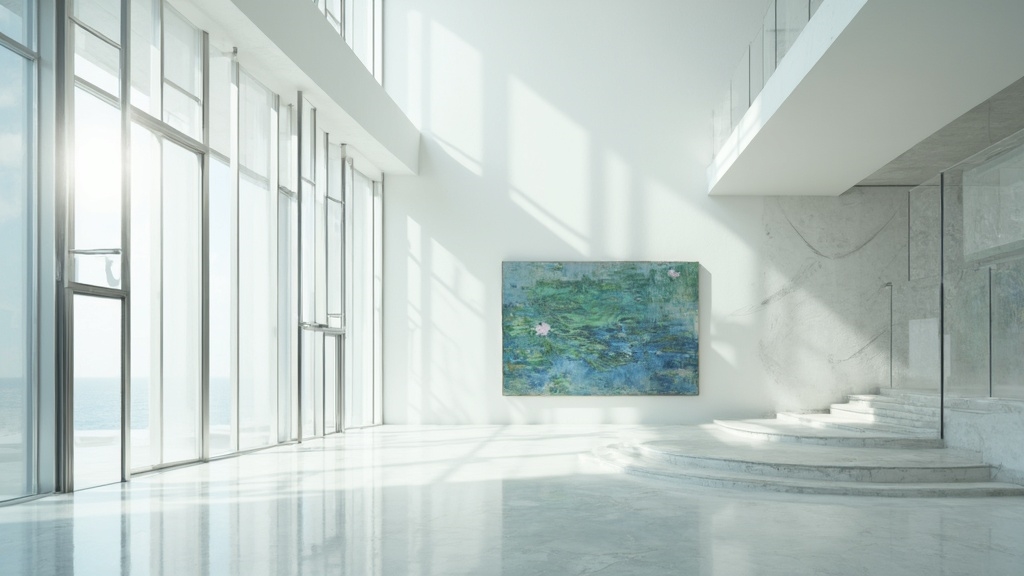
Private art collections in Kanagawa Prefecture highlight exceptional curatorial vision through two prominent institutions: the Pola Museum in Hakone and the Fujiko F Fujio Museum in Kawasaki.
The Pola Museum houses the private collection of Tsuneshi Suzuki, featuring an extensive array of Western and Japanese art. The museum’s diverse holdings include Western paintings, Japanese-style paintings, prints, pottery, glassworks, and cosmetic utensils, offering visitors a thorough artistic experience.
The Fujiko F Fujio Museum celebrates the creative legacy of manga artistry, particularly the beloved Doraemon series. This specialized collection requires advance ticket reservations through Lawson and serves as a cultural repository preserving Japan’s influential contribution to animated storytelling and comic art.
Art Museums Along the Shonan Coast
The Shonan Coast region of Kanagawa Prefecture hosts several notable public art institutions that complement the area’s private collections. The presence of these coastal galleries enhances the cultural landscape while offering visitors opportunities to experience both traditional and contemporary Shonan art in stunning seaside settings.
- The Enoura Observatory stands as an architectural masterpiece overlooking Sagami Bay, featuring contemporary exhibitions, a traditional noh stage, and meditation spaces designed by renowned artist Hiroshi Sugimoto
- Kanagawa Prefectural Museum of Modern Art Hayama presents rotating exhibitions of modern works against the backdrop of Mount Fuji and ocean vistas
- Shonan Nishiwaki Gallery in Fujisawa serves as a cultural hub, showcasing regional artistic expressions while maintaining strong connections to local creative communities
Frequently Asked Questions
What Are the Best Times to Avoid Crowds at Kanagawa’s Major Museums?
Visitors seeking to avoid peak hours should plan museum visits for weekday mornings, particularly Tuesdays through Thursdays. Key timing tips include arriving at opening time and avoiding holidays and school breaks.
Do Any Kanagawa Art Museums Offer Special Programs for Children With Disabilities?
Transformative adaptive programs and sensory activities flourish across museums, with specialized staff guiding children through tailored experiences. Kanagawa’s art institutions offer wheelchair access, though specialized disability programs remain limited.
Which Art Museums in Kanagawa Prefecture Offer Artist-In-Residence or Workshop Opportunities?
Limited information exists regarding artist residency programs in the region. The Yokohama Museum of Art hosts occasional workshops, though specific workshop schedules and residency opportunities require direct inquiry.
How Do Museum Admission Prices in Kanagawa Compare to Tokyo’s Museums?
A family of four saved 2,000 yen through museum discounts at Hakone. While extensive ticket packages exist in both regions, Kanagawa museums generally maintain slightly lower admission prices than Tokyo counterparts.
Are There Shuttle Services Connecting Different Art Museums in Kanagawa Prefecture?
Several shuttle services connect regional museums through established partnerships, with the Pola Museum Shuttle and sightseeing loop buses offering regular schedules between major cultural institutions in the area.
Conclusion
Kanagawa Prefecture’s diverse art museums offer visitors a journey through time, from ancient scrolls to digital installations. Like a vintage iPod shuffling through centuries of creativity, these institutions preserve Japan’s artistic heritage while embracing contemporary expressions. The museums, scattered from Yokohama’s bustling port to the serene Shonan coastline, continue to shape the region’s cultural landscape and inspire new generations of artists.
